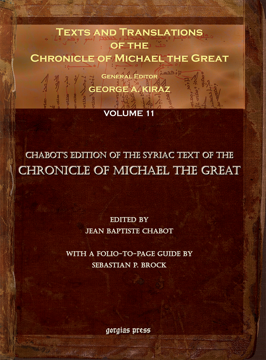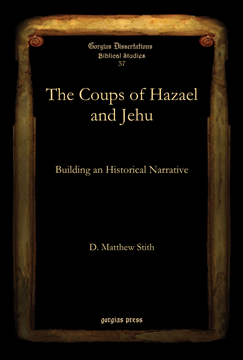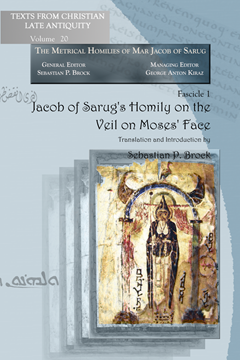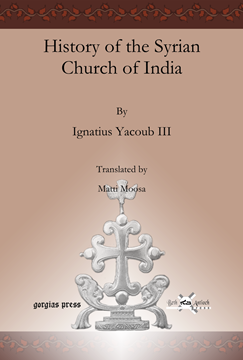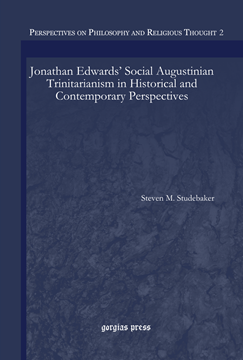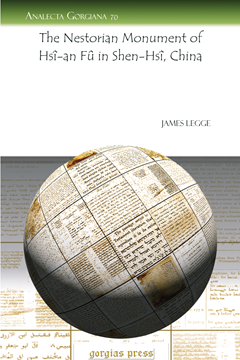Texts and Translations of the Chronicle of Michael the Great (entire set) (11 of 11 volumes)
Syriac Original, Arabic Garshuni Version, and Armenian Epitome with Translations into French
Translated by Isho‘ of Hasankeyf & Vardan Areweltsi; Edited by Tigran Sawalaneants; Introduction by Andrea Schmidt
ISBN: 978-1-59333-703-2
This invaluable eleven-volume set on the Chronicle of Michael the Great makes the scholarly resources on this unique manuscript available together for the first time. Now inaccessible, the Chronicle is the largest medieval chronicle known, and is available here for the first time in history as a facsimile copy of the original manuscript, as well as in a copy of the original Syriac, the French translation, an abbreviated Armenian recension, and Arabic versions. The Chronicle is one of the most important primary sources on the history of the Middle East, especially the period between the rise of Islam and the Crusades.
$269.00 (USD) $161.40 (USD)
Pre-Classical Greece
ISBN: 0-941690-51-2
Noting the standard reservations of Classicists regarding the Greek Bronze and Dark Ages, Carol Thomas declares the Pre-Classical period of ancient Greece to be the locus of much historical information. Both the metaphor and the fact of Troy serve as emblems of this historical enterprise as Thomas organizes her work around the subjects encountered by those approaching this time-frame: the tools (method and dating) and the evidence (writing and oral tradition). A brief account of the war is given in the context of both an actual war and a metaphor. These tools allow her to reconstruct the Mycenaean Age and the Dark Age prior to Classical Greece. A necessary requisite for consideration of the history of Classical Greece, this volume is accessible to scholars and interested laity alike.
$24.00 (USD) $14.40 (USD)
Current Issues and the Study of Ancient History
Edited by Carol G. Thomas
ISBN: 1-930053-10-X
The arrival of new disciplinary approaches to ancient fields of study is embraced in this volume of Publications of the Association of Ancient Historians. This volume considers the world of the Classic civilizations viewed through the lenses of recent approaches to historical material. Stanley M. Burstein considers Egypt and Greece in the light of Afrocentrism as a means of exploring ethnicity in the study of antiquity. Nancy Demand applies the outlook of gender studies to ancient history with the resultant concepts of participation and power. Ian Morris delves into the role archaeology takes in the understanding of ancient Greece, and Lawrence Tritle explores psychology and history in an analysis of Thucydides, a foundational writer of Classical history. These cross-disciplinary studies demonstrate the flexibility and breadth of the historical undertaking in an environment of continual growth and change.
$24.00 (USD) $14.40 (USD)
The Coups of Hazael and Jehu
Building an Historical Narrative
Series: Gorgias Biblical Studies 37
ISBN: 978-1-59333-833-6
The Coups of Hazael and Jehu offers a narrative reconstruction of the events surrounding the rise of Hazael to the throne of Aram-Damascus and Jehu to the throne of Israel in the mid-eighth century. These near-simultaneous dynastic changes were parts of a major shift in the political, military, and economic structure of the Levant, which took place as the mighty armies of Assyria pushed into the region. The book argues that Jehu’s bloody overthrow of Joram and Hazael’s irregular seizure of power after the death of his predecessor were not independent events, but responses to the Assyrian threat.
$132.00 (USD) $79.20 (USD)
Jacob of Sarug’s Homily on the Veil on Moses’ Face
Metrical Homilies of Mar Jacob of Sarug
Translation and Introduction by Sebastian P. Brock
Series: Texts from Christian Late Antiquity 20
ISBN: 978-1-59333-644-8
This edition of Mar Jacob of Sarug's (d. 521) homily on the Veil of Moses asks what the veil means. Jacob finds the hermeneutical key in Paul’s exegesis of Gen. 2:24 – that the man and the woman becoming one symbolizes Christ and the Church. The bride must wear a veil until such time as her bridegroom comes to remove it at their marriage ceremony. The volume constitutes a fascicle of The Metrical Homilies of Mar Jacob of Sarug, which, when complete, will contain the original Syriac text of Jacob's surviving sermons, fully vocalized, alongside an annotated English translation.
$34.00 (USD) $20.40 (USD)
History of the Syrian Church of India
By Ignatius Yacoub III; Translated by Matti Moosa
ISBN: 978-1-59333-982-1
This book covers the history of the Syrian church of India from its founding by the apostle Thomas in 52 A.D., until the first half of the 20th century. During which, the author explains the various obstacles the Indian Church faced in therms of theology and colonialism. The several delegations of the Apostolic See of Antioch to India from the 17th to the 20th centuries form an indispensable account of the vicissitudes of a struggling native Indian Church trying to preserve its Antiochene identity.
$166.00 (USD) $99.60 (USD)
The Edessa-Aleppo Syriac Codex of the Chronicle of Michael the Great
Edited by Gregorios Yohanna Ibrahim; Contribution by Sebastian P. Brock & Hidemi Takahashi; Foreword by George Anton Kiraz
ISBN: 978-1-59333-147-4
The invaluable Chronicle of Michael the Great makes the scholarly resources on this unique manuscript available together for the first time. Now inaccessible, the Chronicle is the largest medieval chronicle known, and is available here for the first time in history as a facsimile copy of the original manuscript. The Chronicle is one of the most important primary sources on the history of the Middle East, especially the period between the rise of Islam and the Crusades.
$292.00 (USD) $175.20 (USD)
Jonathan Edwards’ Social Augustinian Trinitarianism in Historical and Contemporary Perspectives
ISBN: 978-1-59333-846-6
The Trinity played a significant role in Jonathan Edwards’ theology. But what was the nature of his trinitarian theology? A common view among Edwards scholars is that he embraced the dialectical psychological and social models of the Trinity. This study suggests that Edwards consistently used one model of the Trinity—the Augustinian mutual love model. Edwards uses the mutual love model to portray the loving relationships among the divine persons and in doing so stands in continuity with other early-Enlightenment apologists for traditional trinitarianism.
$191.00 (USD) $114.60 (USD)
The Nestorian Monument of Hsî-an Fû in Shen-Hsî, China
By James Legge
Series: Analecta Gorgiana 70
ISBN: 978-1-59333-886-2
The “Nestorian Monument” or “Nestorian Stele” is a fascinating attestation of the work of Syriac-speaking missionaries in sixth-century China. Commemorating the diffusion of Christianity in China from 635-781, the inscription was erected in the latter year as a public monument. The inscription in Chinese, supplemented with some Syriac, provides a brief outline of Christian doctrine and provides an account of how Christianity came to China. This book offers an English translation of the monument along with the original language text.
$47.00 (USD) $28.20 (USD)
Zur Historischen Topographie von Persien
Series: Analecta Gorgiana 80
ISBN: 978-1-59333-855-8
Originally a two-part publication, geographer Wilhelm Tomaschek’s study on the historic topography of Persia is here published in one volume. Beginning with the street layout of the Tabula Peutingerana, the author describes the major routes of the Persian realm as reflected in antiquity. Although reflecting the period of the Qajar Dynasty prior to the developments during the World Wars, this guide still provides historic information concerning the mapping of one of the great empires of the ancient world.
$73.00 (USD) $43.80 (USD)
